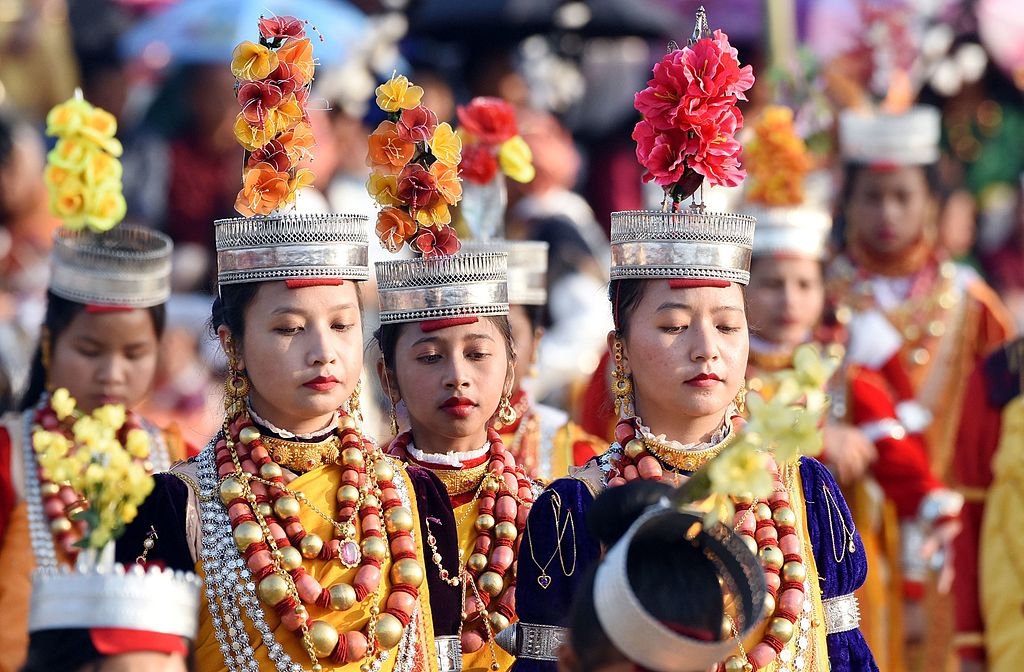Ka Shad Suk Mynsiem also known as the Weiking Dance is a thanksgiving dance festival celebrated by the Khasi tribes of Meghalaya. This dance festival is celebrated every year at the end of the harvesting season in the month of April. During this festival, they sow the seeds for the next season symbolizing the beginning of the new.

Ka Shad Suk Mynsiem Dance
Khasi hills of Meghalaya are known as the land of dance and songs accompanied by a wide variety of unique instruments and music. Khasi people believe that God exists in everyone, be it an animal, a human, or an object. They celebrate the Ka Shad Suk Mynsiem festival signifying the same.
The term Shad Suk Mynsiem literally means the dance for peace and mind. It is called the festival of a blissful soul. The festival is symbolic where the women stand for the seeds and the men are the metaphors of the cultivators. Though every village annually organizes this festival, a very elaborate and vast celebration is held at Shillong. The Seng Khasi leaders annually organize this dance.
Celebration of the Festival
This three-day Ka Shad Suk Mynsiem festival begins with the ‘Shad Nahkjat’. It is a brief opening dance. It starts with a prayer meeting in the Seng Hall Wankhar. Then from that site, the drummers, the pipers, and some of the male members reach the dance site. They are followed by a cheering and joyous crowd.
The actual dance starts in the evening. There is also ‘Shad Wait‘. This part is very beautiful as both males and females take equal participation here. The male performers dance with swords in their right hands and the whitefly flap in their left hand whereas the female artists dance in one big circle.
After ‘Shad Wait’, there comes ‘Shad Mastich‘ which means warrior dance. Here men and women dance in pairs. On the third and the last day, all the performers and the participants say goodbye to the festival by circling the ground thrice and then going back by dancing merrily.
Festival Costume
The performers are elegantly dressed in their traditional attire along with gorgeous ornaments. The female performers wear a crown of pure silver with a white flower called Tiewlasuban attached to the back of the crown. This flower carries the symbolism of purity and beauty.
On the other hand, the male dancer carries a silver quiver with silver arrows on their back. This is the symbol of the pride, valor, and courage shown by their forefathers in order to protect the land and the chastity and purity of the women. The entire land seems like a beautiful canvas painted with a red and yellow hue.
Ka Shad Suk Mynsiem Dance
In the vast ground, the female dancers dance in a circle surrounded by men from all four sides. This represents the male as the protector. But the irony of the festival Ka Shad Suk Mynsiem is that it is also known as the Weiking Dance where the women dancers carry a white handkerchief that stands for their maidenhood and virginity. But on the contrary, there is no such restriction or custom for males.
In this dance festival, the music changes from time to time. According to its rhythm and tune the steps or the pattern of the dance changes. The women dance bare-footed by shuffling, gracefully in the forward and backward motion with their cast down. This reflects their feminine nature whereas the men dance by moving fast with lively and strong steps surrounding the women. This reflects the masculinity representing the men as the savior and the protector of the land, and its inhabitants.
The Garo and Khasi people take part in the festival irrespective of their caste, creed, and gender with full gratitude and respect. The hills get filled with the sound of drums, and pipes. The music echoes everywhere in the valley. The life of the Khasi people is not complete without this festival.
If you plan to visit Meghalaya, choose the month of April. Otherwise, you would miss this wonderful dance festival. Without witnessing this beautiful festival your Meghalaya trip is incomplete.

Pingback: All Folk Dances of India - Auchitya
Pingback: All Folk Dances of India - Auchitya
Pingback: All Folk Dances of India - Statewise Complete List - Auchitya
Pingback: Folk Dances of India – Statewise Complete List